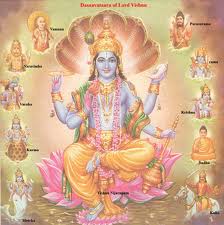Common coverages on most of the Puranas are related to Srishti, Manvantaraas and Vamsas; emphasis is laid on Dasaavataras in general and focussed attention besides the specialised Avataras say like Matsya, Kurma, Varhaha, Vamana, and so on. Of course, treatment of Krishna is strong in some Puranas and is highlighted, say in Bhagavata, Narada, Padma, Brahma Vaivarta, Agni, Brahma, and so on. Details of Dakshayagna, immolation of Sati Devi and the aftermath as also Shiva Parvati’s wedding preceded by ‘Kamadahana’, mediation by Sapta Rishis between Himavanta and Shiva,birth of Skanda Kumara leading to Tarakasura Vadha by Kumara are repeated often by many Puranas like Shiva Purana, Skanda Purana, Matsya Purana,Padma Purana, Bhagavata Purana,Linga Purana and so on.
Vratas are highlighted in almost all the Puranas and great emphasis is laid on the methods of performing the Vratas, shodashopacharas, the details of Mantras, Stutis and phalas in observing the Pujas as illustrated in the ‘Kathas’. Satyanarayana Vrata, Ganesha Chaturthi, Naga Panchami, Skanda Shasthi, Radha saptami, Madhana Dwadashi, Mangala Gauri, Varalashshmi Vrata and so on. In fact, Narada Purana and Bhavishya Purana have mines of Vrata details. So does Matsya Purana which provided an overview of Sixty Four Vratas plus Ananta Triteeya, Saarasvata, Bhima Dwadasi, Shiva Chaturdasa and more Vratas in full details. Nava Graha Puja,and Vaastu Puja are given in great detail in the same Purana. Varaha Purana is yet another Purana specialising in Vratas in respect of each and every Avatara of Vishnu from Matsya to Kalki!
Similarly, considerable importance is given to Tirtha Darshanaas. Outstanding examples of Puranas devoting prominence to Tirthas are Skanda Purana devoting chapters after chapters covering Arunachala, Venkatachala, Puroshotthama Khsetra, Badari/ Kedara, Ayodhya, Rameshwara, Kashi, Avanti, Prabhasa Khetra, Dwaraka, Manasa Tirtha,etc. Padma Purana provides a compendium of endless Tirthas through out the length and breadth of Bharata Varsha. And so does Varaha Purana ranging from Vishnu Para and Shiva Para Tirthas. Siva Purana highlights Dwadasha Linga Darshana viz. Kedara in Himalayas, Bhimashankara in Maharashtra, Visweswara, in Kasi, Triambika in Maharashtra, Somanadha in Sourashtra, Srishaila in Andhra, Mahakaalka in Ujain, Omkara near Ujjain,(M.P), Vaidyanatha at Deogarh (Bihar), Nageswara near Dwaraka (Gujarat), Rameshwara in Tamilnadu, and Ghishneswara in Aourangabad (Maharashtra). There are innumerable Upalingas mentioned in Koti Rudra Samhita! Similarly, fifty one Shakti Peethas spread over the length and breadth of Bharata.
Varnaashrama Dharmas: In Maha Bhagavata, there is a Chapter titled Uddhava Gita, in which Bhagavan Krishna preached to his special devotee named Uddhava that the basic principles of Varnashrama Dharma required a fourfold classification of Brahmanas with the duty of Spiritual and Intellectual pursuits; Vaishyas with the duties involving Finance, Business and farming; Kashatriyas to perform Administration and Defence, and the rest as Labourers and Artisans, besides general services. BUT, the division should be made on the basis of aptitude, regardless of birth; the Veda base was given in Bhagavata allowing persons to accept symptoms of propensity and talent:
‘’Yasya yallakshanam proctum pumso varnaabhivyanjakam,
Yad anyapraapti drusyata tatteniva vinirdisat’’
“(If a person reveals symptoms of being a Brahmana, Kshatriya, Vaisya or others even if he / she may be accepted by the symptoms. BUT, the Regulative Principles do prescribe that the concerned ‘Vidhis’ or definite duties be performed too like refraining from meat (Ahimsa), renouncing intoxicants (Purity of consciousness), resorting to illicit relations with women/men (loyalty and faithfulness) and gambling (illegal acquisition). There are also niyamas or optional duties like Bahyantara Suchi, Japam, meditation, austerity, sacrifice, dependability, hospitality and worship; (Shoucham, Tapas, Swadhyaya or study, Santosha (contentment); Daanam (Charity) and Ishvara Pranadaanam (total dedication), Satsanga, practice of Yoga, Surya Namaskaras.
A Brahmana is one by birth; by virtue of Samskara or training or practice he becomes a Dwija; and by virtue of Vidya or knowledge he is called a Vipra. Thus the features of a proper Brahmana are Janma (birth), Samskara (tradition and training) and Vidya. A fulfledged Brahmana is Vidya, Mantra and Vedas accompanied by practice and penance. Indeed perfect Brahmins in our contemporary world are becoming very few and far between. Such an ideal Brahmana wakes up in the Brahma Muhurta, after prayers to Ishta Devatas of Vishnu-Shiva-Shakti and after morning ablutions takes Snaana rendering Purusha Sukta; performs Sandhya Vandana,Yoga, Surya Namashkara, Pitru Tarpana, Agnihotra homa, Sahasra naama puja and Madhyahna Sandhya. During the day he performs Swadhyaya of Scriptures, Vedanga Pathana/ Practice of Siksha / Sangeeta, Kalpa Grandha,Vyakarana Shastra, Niruka Varnana, Chaanads Shastra, Jyotisha Shastra / Jataka Skandha; Evening Snaana, Sandhyavandana and Evening Puja. It is rather improbable that such ideal Brahmanas are ordinary. The least that one could perform is daily Gayatri Vandana, possibly thrice a day.
 Prev:Chandra and Chandra Vamsha
Prev:Chandra and Chandra Vamsha
 Next:Chandra and Chandra Vamsha
Next:Chandra and Chandra Vamsha